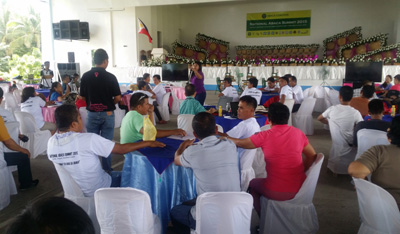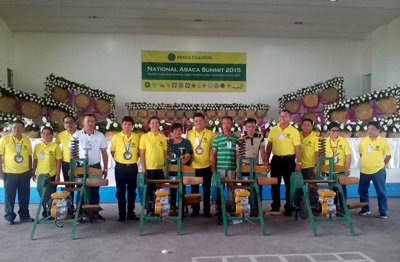SOGOD, Southern Leyte - Abaca Coalition gathered the abaca industry's main players in the first ever Abaca Summit on November 4-5 in a bid to address various concerns that ail the industry.
The summit provided a venue for relevant sectors to tackle pressing issues haunting the country's abaca industry in the midst of climate change and the ASEAN integration, among other challenges.
Hosted by the Southern Leyte State University (SLSU), a member of the Coalition, the two-day summit was attended by Sogod abaca farmers, representatives from national government agencies, regional line agencies, national and local academic institutions, local government units, and the private sector. The Coalition's mission--develop an integrated action plan for advancing abaca in Region 8 and reduce the same to a manifesto, which will be considered for legislation.
 Based on priority issues identified during the summit, the Coalition, with the help of Sogod abaca farmers, representatives from the abaca fiber and pulp industry, and concerned government agencies developed the joint action plan.
Based on priority issues identified during the summit, the Coalition, with the help of Sogod abaca farmers, representatives from the abaca fiber and pulp industry, and concerned government agencies developed the joint action plan.
The plan proposed the establishment of barangay nurseries, putting up of an integrated disease management scheme, production of tissue-cultured planting materials, development of an incentive-based expansion of the planting areas especially those within the forest cover, providing trainings for farmers on fiber quality, and developing a baseline of abaca farms as a support system for decision making.
With these efforts, Abaca Coalition members expect to have one hundred hectares of land planted to abaca in Region 8 within one year. Fifty hectares of these plantations are expected to be sustainably certified inasmuch as certification for sustainability of abaca plantation is a requirement in foreign trade.
The summit witnessed the turnover of stripping machines to the communities of Maac, Mahayahay, Javier and Maria Plana in Sogod, Southern Leyte, for the use of abaca farmers in the said barangays.
 The machine is designed and developed by the National Abaca Research Center based at the Visayas State University in Baybay, Leyte. Four units of this machine were purchased through a research and development grant from the Philippine Council for Agriculture, Aquatic and Natural Resources Research and Development of the Department of Science and Technology (DOST-PCAARRD).
The machine is designed and developed by the National Abaca Research Center based at the Visayas State University in Baybay, Leyte. Four units of this machine were purchased through a research and development grant from the Philippine Council for Agriculture, Aquatic and Natural Resources Research and Development of the Department of Science and Technology (DOST-PCAARRD).
Using the machine, four persons can harvest one hectare of abaca plantation in 7-8 days. It weighs only 93 kg, can be dismantled and carried in areas not accessible by transportation. It can strip native abaca varieties by replacing stripping blades for variable quality, recovery, and output.
An economically important crop indigenous to the Philippines, abaca is the lifeblood of more than 200,000 farming families from 56 abaca growing provinces in the country. It boasts of high demand as raw material for textile, handicrafts, specialty papers, and just recently as dashboards and interior for cars, among other products.
Although the country has maintained its stature as the biggest supplier of abaca products, the country’s abaca production has declined in the past years due to several constraints. These include lack of high-yielding and virus-resistant planting materials and prevalence of pest and diseases, most notorious of which is the abaca bunchy top virus (ABTV).
The government, through DOST-PCAARRD and its partners, is pushing several S&T interventions to address poor technology adoption of farmers. Most notable of these interventions is the Industry Strategic S&T Plan (ISP) for Abaca.
 As a Coalition member, the Worldfish Organization, an international research organization that harnesses fisheries and aquaculture to reduce hunger and poverty, spearheaded the summit in consonance with its Aquatic Agricultural Systems (AAS) program.
As a Coalition member, the Worldfish Organization, an international research organization that harnesses fisheries and aquaculture to reduce hunger and poverty, spearheaded the summit in consonance with its Aquatic Agricultural Systems (AAS) program.
Other members of the Coalition include state colleges and universities, government research institutions, private organizations, municipal and barangay government units, and the media.
Having started from the dreams of Sogod farmers in rehabilitating the abaca farms in Maac and Mahayahay as an additional source of livelihood, the abaca project expanded to include Maria Plana and Javier, two other barangays in Sogod.
A mini exhibit of local products, which make use of abaca fiber, abaca yarn, abaca wastes, and reject fibers, was also put up during the exhibit. The products include utility boxes, gift boxes, tables, bags, and other products.
The summit winded up with the Coalition members signing the pledge of commitment for the interest of the abaca industry on a commitment tarp bearing the tagline “Hayag ang ugma ta diha sa abaka (We have a bright future in abaca)”.
